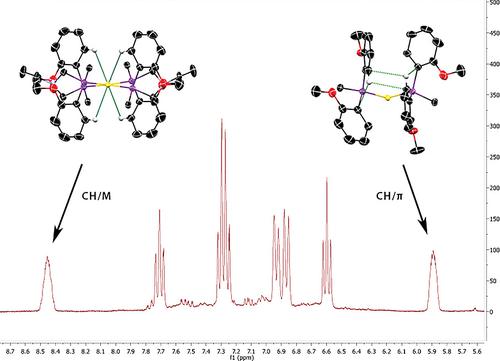当前位置:
X-MOL 学术
›
Eur. J. Inorg. Chem.
›
论文详情
Our official English website, www.x-mol.net, welcomes your
feedback! (Note: you will need to create a separate account there.)
Versatile Production of Novel PNP Based Metal Complexes Applicable as Water Reduction Catalysts Showing CH/M as Well as CH/π Interactions
European Journal of Inorganic Chemistry ( IF 2.2 ) Pub Date : 2020-10-13 , DOI: 10.1002/ejic.202000778 Richard Pehn 1 , Johann Pann 1 , Katharina Ehrmann 1 , Wolfgang Viertl 1 , Helena Roithmeyer 1 , Marvin Bendig 1 , Christof Strabler 1 , Holger Kopacka 1 , Thomas Müller 2 , Thomas Hofer 1 , Peter Brüggeller 1
European Journal of Inorganic Chemistry ( IF 2.2 ) Pub Date : 2020-10-13 , DOI: 10.1002/ejic.202000778 Richard Pehn 1 , Johann Pann 1 , Katharina Ehrmann 1 , Wolfgang Viertl 1 , Helena Roithmeyer 1 , Marvin Bendig 1 , Christof Strabler 1 , Holger Kopacka 1 , Thomas Müller 2 , Thomas Hofer 1 , Peter Brüggeller 1
Affiliation

|
Several PNP‐type ligands of the form bis(dianisylphosphanylmethyl)alkylamine, where alkyl is methyl, ethyl, isopropyl, and benzyl (1–4), have been coordinated to Co(II), Ni(II), Pd(II), and Pt(II) (5–26). This series of water reduction catalysts (WRC) has been characterized by single‐crystal X‐ray structure analysis, multinuclear and 2D NMR spectroscopy, mass spectrometry and a computational study. Intramolecular contact approaches show differences depending on hetero‐ or homoleptic complexes. Both solid state and solution structures indicate an enhancement of steric pressure for the latter. As a consequence CH/M as well as CH/π interactions appear in the X‐ray structures and 1H NMR spectra. They can also be clearly identified by quantum mechanical calculations on a B3LYP level. Since these WRC contain proton relays due to the used PNP‐ligands, they are prone to proton coupled electron transfer (PCET) during photocatalysis. The different steric pressure influences their reorganisation energy. Obviously, the observed intramolecular contact approaches should be regarded as a tool for the design of future WRC.
中文翻译:

多功能生产新型PNP基金属配合物,可用作CH / M以及CH /π相互作用的减水催化剂
几种双(二茴香基膦基甲基甲基)烷基胺形式的PNP型配体已与Co(II),Ni(II),Pd(II)配合,其中烷基为甲基,乙基,异丙基和苄基(1-4)。和Pt(II)(5–26)。该系列减水催化剂(WRC)的特征在于单晶X射线结构分析,多核和2D NMR光谱,质谱和计算研究。分子内接触方法显示出差异,这取决于杂合或纯合复合物。固态和溶液结构都表明后者的空间压力增加。结果,CH / M以及CH /π相互作用出现在X射线结构中,并且11 H NMR谱。也可以通过B3LYP级别的量子力学计算清楚地识别它们。由于这些WRC由于使用了PNP配体,因此包含质子中继,因此在光催化过程中它们易于发生质子耦合电子转移(PCET)。不同的空间压力影响其重组能量。显然,观察到的分子内接触方法应被视为未来WRC设计的工具。
更新日期:2020-12-08
中文翻译:

多功能生产新型PNP基金属配合物,可用作CH / M以及CH /π相互作用的减水催化剂
几种双(二茴香基膦基甲基甲基)烷基胺形式的PNP型配体已与Co(II),Ni(II),Pd(II)配合,其中烷基为甲基,乙基,异丙基和苄基(1-4)。和Pt(II)(5–26)。该系列减水催化剂(WRC)的特征在于单晶X射线结构分析,多核和2D NMR光谱,质谱和计算研究。分子内接触方法显示出差异,这取决于杂合或纯合复合物。固态和溶液结构都表明后者的空间压力增加。结果,CH / M以及CH /π相互作用出现在X射线结构中,并且11 H NMR谱。也可以通过B3LYP级别的量子力学计算清楚地识别它们。由于这些WRC由于使用了PNP配体,因此包含质子中继,因此在光催化过程中它们易于发生质子耦合电子转移(PCET)。不同的空间压力影响其重组能量。显然,观察到的分子内接触方法应被视为未来WRC设计的工具。











































 京公网安备 11010802027423号
京公网安备 11010802027423号